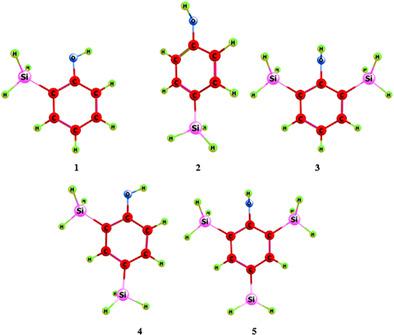当前位置:
X-MOL 学术
›
J. Chin. Chem. Soc.
›
论文详情
Our official English website, www.x-mol.net, welcomes your feedback! (Note: you will need to create a separate account there.)
Novel silylphenol antioxidants by density functional theory
Journal of the Chinese Chemical Society ( IF 1.8 ) Pub Date : 2020-07-24 , DOI: 10.1002/jccs.202000131 Mojgan Ayoubi-Chianeh 1 , Mohamad Z. Kassaee 1
Journal of the Chinese Chemical Society ( IF 1.8 ) Pub Date : 2020-07-24 , DOI: 10.1002/jccs.202000131 Mojgan Ayoubi-Chianeh 1 , Mohamad Z. Kassaee 1
Affiliation

|
We have scrutinized five novel silylphenol antioxidants, including 2‐silylphenol (1), 4‐silylphenol (2), 2,6‐disilylphenol (3), 2,4‐disilylphenol (4), and 2,4,6‐trisilylphenol (5), at M06/6–311++G** level of theory. To evaluate the antioxidant efficiency, the electronic effects on O─H bond dissociation energy (BDE) and vertical ionization potential (IPv) of 1–5 are investigated, which are mainly governed by electronic effects. The conductor‐like polarized continuum model (CPCM) is applied to measure the antioxidant capacity in the solution phase. The results show that antioxidants with the lowest BDE and IPv values can efficiently act via hydrogen atom transfer (HAT) and single electron transfer (SET) mechanisms, respectively. The stability of resulting radicals is measured by nucleus independent chemical shift (NICS) index, natural bond orbital (NBO) analysis, and nucleophilicity (N) index. The BDE shows lower values in the gas phase with respect to water, while water exhibits lower IPv values than gas. Structure 5 turns out as the most efficient antioxidant. The overall order of antioxidant efficiency in both gas and water phases is 5 > 2 > 3 > 4 > 1.
中文翻译:

基于密度泛函理论的新型甲硅烷基酚抗氧化剂
我们已经仔细研究了五种新颖的甲硅烷基酚抗氧化剂,包括2-甲硅烷基酚(1),4-甲硅烷基酚(2),2,6-二甲硅烷基苯酚(3),2,4-二甲硅烷基苯酚(4)和2,4,6-三甲硅烷基苯酚(5),理论水平为M06 / 6–311 ++ G **。为了评估抗氧化剂效率,上O─H键离解能(BDE)和垂直电离势(IP的电子效应v)的1 - 5进行了研究,这是由电子效应主要支配。使用类似导体的极化连续体模型(CPCM)来测量溶液相中的抗氧化能力。结果表明,BDE和IP v最低的抗氧化剂这些值可以分别通过氢原子转移(HAT)和单电子转移(SET)机制有效地发挥作用。通过核独立化学位移(NICS)指数,自然键轨道(NBO)分析和亲核性(N)指数来测量所得自由基的稳定性。BDE相对于水在气相中显示出较低的值,而水显示出的IPv值低于气体。结构5被证明是最有效的抗氧化剂。气相和水相中抗氧化剂效率的总体顺序为5 > 2 > 3 > 4 > 1。
更新日期:2020-07-24
中文翻译:

基于密度泛函理论的新型甲硅烷基酚抗氧化剂
我们已经仔细研究了五种新颖的甲硅烷基酚抗氧化剂,包括2-甲硅烷基酚(1),4-甲硅烷基酚(2),2,6-二甲硅烷基苯酚(3),2,4-二甲硅烷基苯酚(4)和2,4,6-三甲硅烷基苯酚(5),理论水平为M06 / 6–311 ++ G **。为了评估抗氧化剂效率,上O─H键离解能(BDE)和垂直电离势(IP的电子效应v)的1 - 5进行了研究,这是由电子效应主要支配。使用类似导体的极化连续体模型(CPCM)来测量溶液相中的抗氧化能力。结果表明,BDE和IP v最低的抗氧化剂这些值可以分别通过氢原子转移(HAT)和单电子转移(SET)机制有效地发挥作用。通过核独立化学位移(NICS)指数,自然键轨道(NBO)分析和亲核性(N)指数来测量所得自由基的稳定性。BDE相对于水在气相中显示出较低的值,而水显示出的IPv值低于气体。结构5被证明是最有效的抗氧化剂。气相和水相中抗氧化剂效率的总体顺序为5 > 2 > 3 > 4 > 1。


























 京公网安备 11010802027423号
京公网安备 11010802027423号